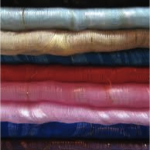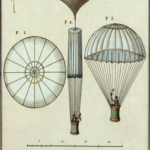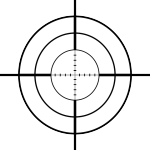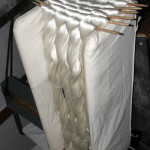From parachutes to printing, medicine to the military – there is more to silk than meets the eye
 Back in the depth of history right up to futuristic ambitions, designers, scientists and engineers have found that silk has far more uses than just a beautiful blouse.
Back in the depth of history right up to futuristic ambitions, designers, scientists and engineers have found that silk has far more uses than just a beautiful blouse.
Hidden talents – antibacterial, strong and absorbent
On the surface the look and feel of silk is one of pure luxury – smooth, soft and incredible comfortable. It drapes perfectly, has a lustre and sheen without being slippery or clingy.
But under that pretty surface lies a mass of impressive properties. This breathable fabric is cool in summer warm in winter. What’s more it is also hypoallergenic and naturally antibacterial, making it perfect for sensitive skins.

Da Vinci’s designs for an early silk parachute
Silk is also incredibly tough and durable, in fact it is the strongest natural fabric we have. There is a reason silk has been used to make parachutes and hot air balloon canopies. Comparable to steel in terms of strength yet amazingly lightweight, silk is tear-resistant and ten times stronger than nylon.
Silk is also one of the most absorbent natural fabrics making it perfect for dyeing and printing – producing wonderfully vivid colours and striking patterns. Its absorptive capacity also means that it is ideal for wearing in warmer climates – easily wicking moisture away from the skin.
What you may be surprised to learn is that silk has found its home in a number of novel places.
The original crosshairs

Originally silk was used to make crosshairs.
Crosshairs are the fine intersecting lines you see when you look through a microscope, telescope or the barrel of a shotgun. It helps you focus and aim with greater accuracy.
Today crosshairs, or reticle, are made with thin wire or actually etched into the glass. However, originally surveying and astronomy instruments used the fine silk from the cocoon of the brown recluse spider.
Stronger than a speeding bullet?

Mongol warriors wore silk to protect them from swords and arrows.
The ancient Mongol warriors wore Chinese silk underwear beneath their armour and it wasn’t just for its warmth and comfort. This underwear gave substantial protection from knives, swords and arrows. Indeed, even if an arrow pieced the skin the silk would often remain intact, making it easier to remove and less likely for the warrior to be poisoned or infected from the wound.
In Thailand a cheaper, lighter, more flexible version of a bulletproof vest has been trialled – a jacket made from 16 layers of fine Thai silk. Tests have shown the silken vest is capable of stopping a 9mm bullet, leaving the wearer unharmed.
And in the US, military scientists are hoping to use synthetic spider silk to produce a bulletproof vest that will be stronger than Kevlar and undetectable under clothing.
A medical marvel – silk’s future in medical advances

Silk raw
A bone graft is an extremely arduous medical procedure, at present surgery uses either metal or ceramic polymers, which lack flexibility, or biomaterials such as collagen, which lack strength.
However, developments have been made which could enable surgeons to repair broken bones with a 100% pure silk fiber that will slowly dissolve. Medical engineers at Tufts University, Massachusetts, have made screws from medical grade silk. So far it has only been tested on lab rats but the team behind it are extremely hopefully, and foreseen the material being used for a wide range of orthopaedic devices.
Another type of silk-based ligament tissue is also being worked on. This is a kind of knitted silk mesh with freeze-dried silk micro sponges inside. It would work like a ligament inside our bodies, providing not only a scaffold but also able to transport nutrients.
A second skin
A group of specialists at the Department of Plastic, Hand and Reconstructive Surgery in Germany have combined human skin cells with spider silk meshwork to produce a synthetic skin. The natural properties of the silk combine with the cells far more successfully than other engineered fibres. Unfortunately, the likelihood of producing this artificial skin on a large scale is hugely impractical due to the difficulty in harvesting the rare silk.

Silk – beautiful and amazingly versatile
Other fascinating developments have been made using silk fibroin, the silk outer layer, to create micro tubes that can be used in the repair of blood vessels. The properties of silk lend itself perfectly to the replication of vessels, structurally ideal with higher burst pressures and increased permeability.
Scientists are even working on a way to use silk to repair heart tissue. At the Max Planck Institute for Heart and Lung Research silk of the tropical tasar silkworm has been used to produce artificial cardiac tissue. Our hearts are unable to repair themselves, scar tissue forms and cardiac muscle can never regenerate. Therefore, this breakthrough, although still in the early stages of develop could greatly increase the life expectancy of those with heart conditions.
Silk really is an incredible material – there are few natural things in this world that offer far more than man is capable of artificially producing, it is something that science cannot better, only hope to emulate. And it is so rare to find something that has both brawn and beauty – equally tough and delicate.
